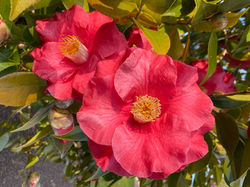
Admission Prices:
-
Adults $22.00
-
Concession $17.00
-
Family $52.00
-
Student $17.00
-
Locals $17.00
-
Children $12.00
-
Children under 5 years FREE
Please email info@cowragarden.com.au for tour group booking prices
We are a registered charity, and donations of $2 or more are eligible for tax deductions.
Opening Hours 8.30am- 5.00pm
 |  |  |  |  |  |
|---|---|---|---|---|---|
 |  |  |  |  |
Our History

Origin of Relations between Cowra and Japan
Cowra Japanese Garden and Cultural Centre was established to recognize and develop the relationship between the people of Cowra Shire and the people of Japan, a relationship that has its origins in the Prisoner of War Camp that housed the Japanese P.O.W’s during World War II.
In 1960 the Japanese Government decided to bring all their war dead from parts of Australia to be re-buried at Cowra. This was the beginning of the friendship between Japan and the town of Cowra.


Object and Purposes of the Garden and Cultural Centre
The principal object and purpose of the Cowra Japanese Garden and Cultural Centre is the promotion of:
-
Japanese Design (including landscape, garden and built form design)
It is also very important that the Cowra Japanese Garden and Cultural Centre support and advance the cultural relations between the people of Cowra Shire in New South Wales and the people of Japan.
The Cowra Japanese Garden and Cultural Centre organises a number of activities at relevant times throughout the year to promote its principal objects. These activities include:
-
Invited guest speakers regularly recount the fascinating story of the 1st Shogun, Tokugawa Ieyasu and the history of the first Japanese landscape garden built by Shogun Ieyasu and explain the design features incorporated into the Cowra Japanese Garden, which replicates a traditional strolling garden from the Edo Period in its design
-
Walk through the Garden discovering and exploring the many aspects of Japanese landscape, garden and built form design, incorporated into the Garden
-
Traditional Japanese ceremonies conducted in the Arbor, the Tea House and the Edo Cottage, which have all been constructed to replicate traditional Japanese built form design
-
Japanese ceremonies such as a traditional tea ceremony which features relevant items of Japanese movable cultural heritage
-
Exhibitions of numerous pieces of Japanese movable cultural heritage including a Somenishiki vase standing 1.4 metres high which has a twin at the Japanese Imperial Palace in Japan and a Japanese scroll produced in 1580
-
Demonstrations by experts in traditional Japanese crafts such as calligraphy, origami and ikebana (Japanese flower arrangement)
-
Japanese craft workshops for juniors and school groups
-
Informative talks and guided tours conducted by our Education Staff are available to school groups and other group visitors to the Garden.